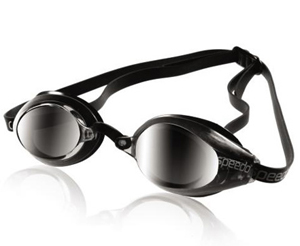How to Choose Racing Swim Goggles
 Racing goggles are goggles used primarily in competition, whether that means at swim meets or open water events. Racing goggles should do two things: The first is to provide clear vision as you swim, and the second is to create as little drag as possible. Swim meets and open water swimming events each have slightly different goggles requirements, explained below.
Racing goggles are goggles used primarily in competition, whether that means at swim meets or open water events. Racing goggles should do two things: The first is to provide clear vision as you swim, and the second is to create as little drag as possible. Swim meets and open water swimming events each have slightly different goggles requirements, explained below.
Racing Goggles for Swim Meets
Races that take place in pools often come down to hundredths of a second, which means that every tiny detail of the race is important… down to the goggles the swimmer wears. Many competitive swimmers own a pair of goggles they use exclusively for racing. This pair should fit them especially well and not slow them down in the water. Below are the three important details to think about when choosing any pair of swim racing goggles.
Goggle Fit
Racing goggles need to be hydrodynamic, with a lens that fits cleanly into the socket, and without any protruding pieces that will catch water. Most goggles these days are very hydrodynamic, and there isn't much difference between practice goggles and racing goggles in this area. Small and curved lenses generate the least drag in the water.
Goggle Strap
The straps on your racing goggles should life flat against your head. Silicone or rubber straps will provide the best snug, budge-free grip unlike bungee straps that fasten with a toggle (and will generate more drag). Also make sure that the goggle straps don't have excess strap material hanging off the sides or back, as this also generates drag.
Goggle Lens
One of the most important things a goggle lens should do is stay clear. To that end, make sure any goggle lens you purchase has an anti-fog coating. If you are a backstroke racer and race outside, look for shaded or metallic lenses that will cut down on glare. Recently, some brands have begun to offer racing goggles with a split lens. In the case of these split lens goggles, the bottom half of the lens is angled downward, making it easier for swimmers to look at the end of the pool or the bottom without moving their heads and affecting their body position.
Racing Goggles for Open Water Swimming
Open water swimmers and triathletes know that swimming lakes or the ocean is a far cry from a perfectly clear, well-lit swimming pool environment. Open water swim races rarely come down to hundredths of second, so hydrodynamics take a back seat to fit and comfort. Because of these differences — as well as the fact that open water swims tend to be much longer than pool-based swim races — racing goggles for open water swimming come with a slightly different set of requirements, outlined below.
Goggle Fit
Because goggles are worn for long stretches — miles at a time — open water racing goggles should be very comfortable. That means that you should look for model with a soft gasket or seal that evenly distributes pressure over the eye socket. In this case, the tight "swedes" often worn at swim meets would quickly become very uncomfortable. Test out goggles beforehand to see which ones fit your face the best. What works best for one person for long periods in the water will not necessarily be the same for someone else.
Goggle Strap
Look for a goggle strap that is wide and flat. The more the strap distributes pressure over the head, the more comfortable it will be. Also, a split or dual strap design provides a more secure fit, and one that is less likely to need to be adjusted during the swim.
Goggle Lens
Again, goggles lenses with anti-fog coating are important. Stopping to wipe condensation out of lenses during an open water swim is an unwelcome delay. Open water swimmers also need increased peripheral vision, both for improved vision underwater as well as easier sighting above the water. Many goggle models come with lenses that are larger and curved specifically for this purpose.
Since the water during open water swim is often darker or murkier than that of pool water, you may not want tinted or metallic lenses (though if you are swimming on a bright day, in clear water, they may be a good idea). Know your environment, and plan accordingly.
All Goggles are "Racing Goggles"
It's important to remember that nearly any goggle can function as a racing goggle. It all comes down to what fits your face and meets your needs. Your racing goggles may be the exact same pair of goggles you wear to swim practice every day, but they may also be a highly-specialized pair that fits the contours of your face and helps you shave precious seconds off your time in the water. Practice diving, sprinting, or hitting the open water in your racing goggles before race day to make sure you have the pair that is perfect for you.
